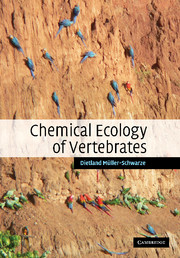Book contents
- Frontmatter
- Contents
- Preface
- Acknowledgements
- 1 The odorsphere: the environment for transmission of chemical signals
- 2 Properties of vertebrate semiochemicals
- 3 Odor production and release
- 4 Chemical cues in orientation and navigation
- 5 Chemoreception
- 6 Signaling pheromones I: discrimination and recognition
- 7 Signaling pheromones II: sex and alarm pheromones and evolutionary considerations
- 8 Intraspecific signals: priming pheromones
- 9 Development of intra- and interspecific chemical communication
- 10 Allomones I: chemical defense by animals
- 11 Allomones II: plant chemical defenses against herbivores
- 12 Kairomones and synomones
- 13 Practical applications of semiochemicals
- Glosssary
- References
- Index
10 - Allomones I: chemical defense by animals
Published online by Cambridge University Press: 23 November 2009
- Frontmatter
- Contents
- Preface
- Acknowledgements
- 1 The odorsphere: the environment for transmission of chemical signals
- 2 Properties of vertebrate semiochemicals
- 3 Odor production and release
- 4 Chemical cues in orientation and navigation
- 5 Chemoreception
- 6 Signaling pheromones I: discrimination and recognition
- 7 Signaling pheromones II: sex and alarm pheromones and evolutionary considerations
- 8 Intraspecific signals: priming pheromones
- 9 Development of intra- and interspecific chemical communication
- 10 Allomones I: chemical defense by animals
- 11 Allomones II: plant chemical defenses against herbivores
- 12 Kairomones and synomones
- 13 Practical applications of semiochemicals
- Glosssary
- References
- Index
Summary
The ‘bonnacon’ [bison] “… emits a fart with the contents of his large intestine which covers three acres, any tree that it reaches catches fire and its pursuers are driven off with the noxious excrement …”
[Clearly, an exaggeration] anon (c. 1150) Bestiary (transl. and ed. T. H. White) New York: Putnam.Allomones are interspecific semiochemicals that primarily benefit the sender. Animals as well as plants defend themselves chemically against predators. Myriads of ways to deter predation have evolved. Many chemicals have more than one function, being aimed not only at predators but also at parasites, prey, or conspecific competitors. As common denominator of allomones we assume that the inclusive fitness of the sender – rather than the receiver – is enhanced. Chapter 10 deals with defenses by animals, and Chapter 11 with plant defenses against herbivores.
Numerous ingenious chemical defense mechanisms of vertebrates protect against predators, but also against competitors and fierce prey. These range from innocuous odors of prey animals or plants that signal that they are unpalatable to some of the most toxic secretions known in nature. Slower animals tend to rely more on chemical and mechanical defenses. Humans have known animal toxins since time immemorial and medical research has elucidated the mechanisms involved in great detail. However, ecologists have investigated why animals and plants have poisons and venoms in the first place only since the 1950s.
Fish
Among fish we find some of the most potent toxins in animals. We distinguish passively toxic fish from actively toxic fish. The former simply have toxins in their tissues, typically taken from some other source such as their diet.
- Type
- Chapter
- Information
- Chemical Ecology of Vertebrates , pp. 246 - 269Publisher: Cambridge University PressPrint publication year: 2006



